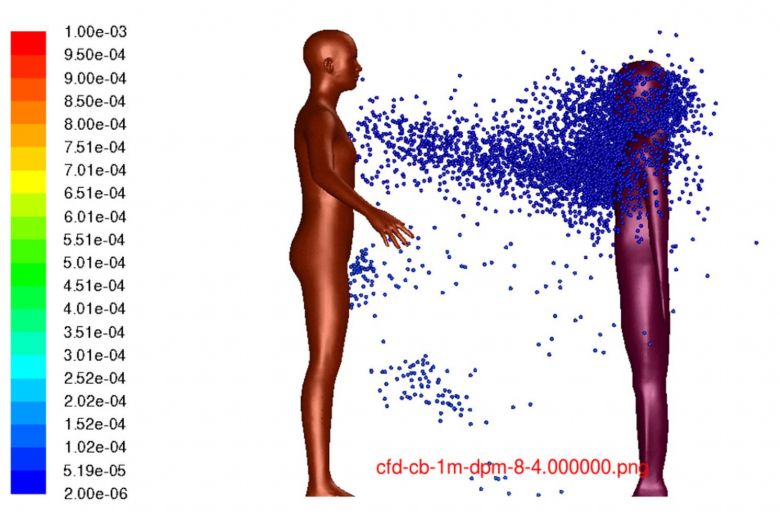
Researchers discovered that a 100 micrometre cough droplet can travel up to 6.6m at a wind speed of 2m per second if the person who coughs is not wearing a mask. GRAPHIC: A*STAR via The Straits Times
SINGAPORE – Researchers here have developed a simulation which more accurately models the spread of droplets when a person with Covid-19 coughs in Singapore’s tropical environment.
A team from the Agency for Science, Technology and Research’s (A*Star) Institute of High Performance Computing said with the ability to simulate this, they are working with public agencies to plan group size limits and safe management measures.
The institute’s executive director Lim Keng Hui told The Straits Times on Thursday (Nov 5) that while other studies had been done on the spread of cough droplets, they did not take into account factors important to Singapore, starting with the climate here.
Dr Lim said: “Singapore has a tropical climate, which is why we use some of the environmental conditions of humidity that match (levels) in Singapore.
“The transport of droplets in a tropical climate will be quite different from a temperate climate, which would be drier.”
Fellow researcher Kang Chang Wei added that some previous studies had also made assumptions about droplets as they fly through the air, which did not apply to Singapore.
Dr Kang, who is a senior scientist at the institute, said that these other studies either assume that a droplet will evaporate completely during its flight and disappear, or not evaporate at all.
But in Singapore’s humid climate, large cough droplets will evaporate partially, leaving behind a smaller droplet – which can then be carried even further by the wind.
The scientists took these factors into account in their simulation, which was published in the journal Physics of Fluids on Nov 3.
Working closely with the National Supercomputing Centre, they fed a combination of physics and mathematical equations, based on prior studies on the coronavirus, into a supercomputer to produce their simulation.
The accuracy of the simulation was further verified by A*Star’s Institute of Materials Research and Engineering, which used an aerosol generator to recreate the simulated scenarios in real life.
Among their many findings, the researchers discovered that a 100 micrometer (µm) cough droplet can travel up to 6.6m at a wind speed of 2m per second (m /s), if the person who coughs is not wearing a mask.
Although droplets of multiple sizes are produced when coughing, Dr Kang said 100µm is the average size of a droplet, and 2m/s is the average wind speed in Singapore.
The researchers added that in their present simulation, Singapore’s safe management measures are effective in mitigating the risk of Covid-19 spread.
Dr Lim said: “Our research has shown scientific proof that it is very important to wear a mask, practice good personal hygiene, social distancing, and ensure the environment is well ventilated, as all these things help to collectively lower the risk of transmission.”
Dr Kang said their model can be applied to create a variety of “what if” scenarios.
This will help the authorities to more accurately plan for safe management measures in the future, as they now have an additional scientific tool to assess the risk of coronavirus spread at an event.
Added Dr Lim: “Now you’re able to know very precisely… to really understand the risk. That way, as you’re trying out various safe distancing measures such as (increasing) capacity, we have a very scientific based, quantifiable, evidence based approach to design them.”